Managing Entrepreneurship, Innovation and Creativity
VerifiedAdded on 2023/01/13
|12
|3538
|79
AI Summary
This document discusses the concepts of managing entrepreneurship, innovation, and creativity. It covers topics such as social entrepreneurship, motivation behind setting up a social enterprise, and the concept plan for a social entrepreneurship venture. The document provides insights into market research, target market, marketing strategies, human resources, and operations. It also includes references for further reading.
Contribute Materials
Your contribution can guide someone’s learning journey. Share your
documents today.
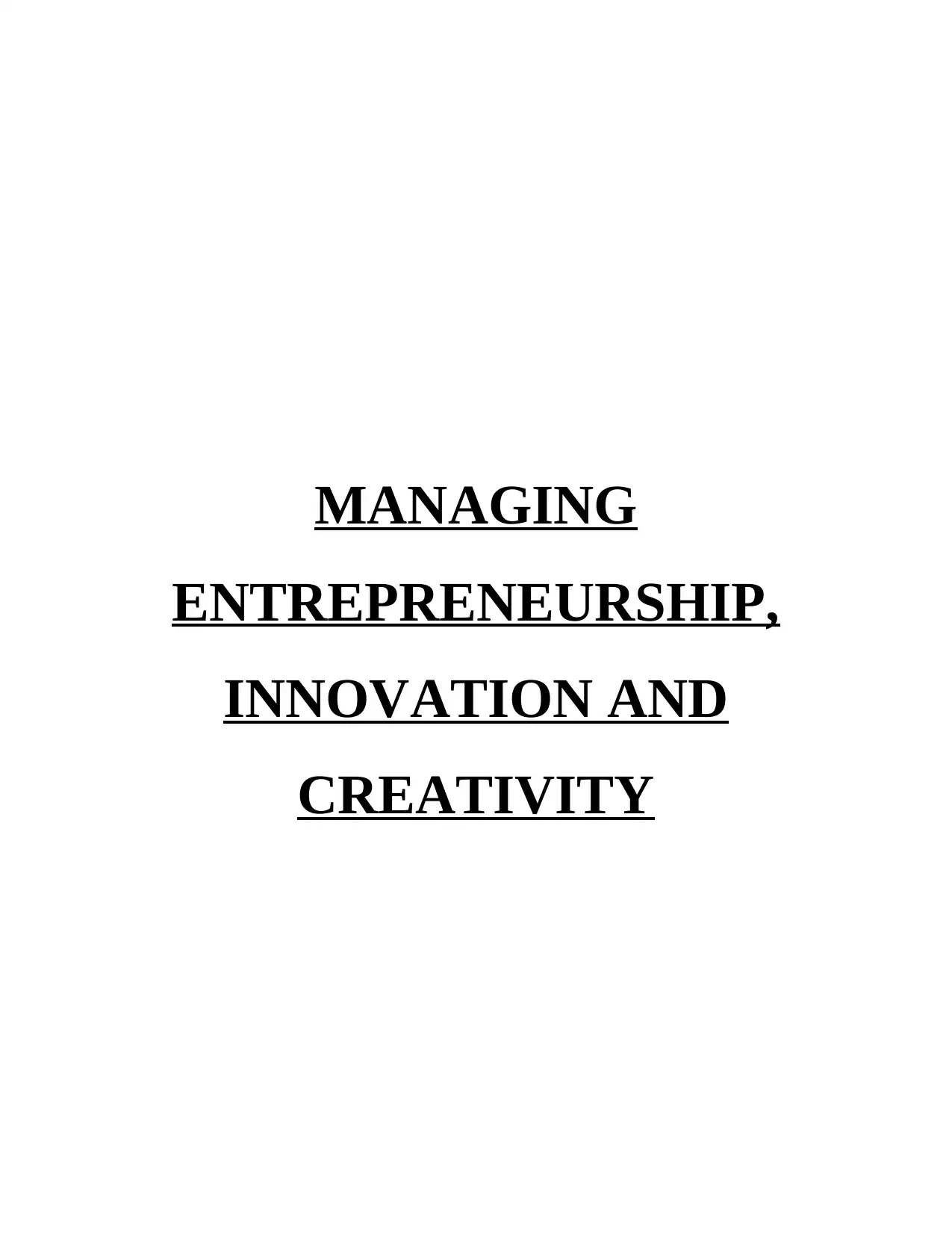
MANAGING
ENTREPRENEURSHIP,
INNOVATION AND
CREATIVITY
ENTREPRENEURSHIP,
INNOVATION AND
CREATIVITY
Secure Best Marks with AI Grader
Need help grading? Try our AI Grader for instant feedback on your assignments.
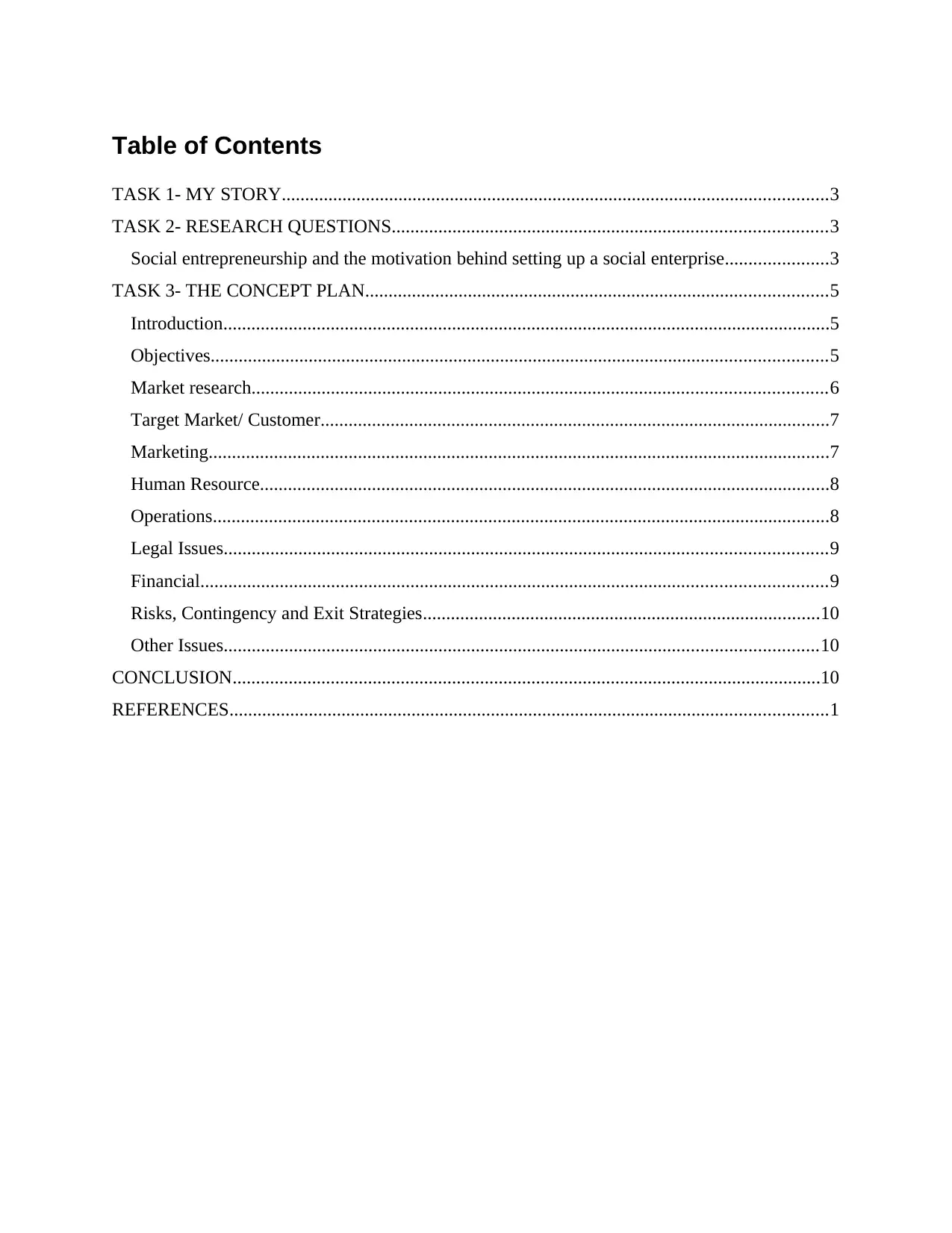
Table of Contents
TASK 1- MY STORY.....................................................................................................................3
TASK 2- RESEARCH QUESTIONS.............................................................................................3
Social entrepreneurship and the motivation behind setting up a social enterprise......................3
TASK 3- THE CONCEPT PLAN...................................................................................................5
Introduction..................................................................................................................................5
Objectives....................................................................................................................................5
Market research...........................................................................................................................6
Target Market/ Customer.............................................................................................................7
Marketing.....................................................................................................................................7
Human Resource..........................................................................................................................8
Operations....................................................................................................................................8
Legal Issues.................................................................................................................................9
Financial......................................................................................................................................9
Risks, Contingency and Exit Strategies.....................................................................................10
Other Issues...............................................................................................................................10
CONCLUSION..............................................................................................................................10
REFERENCES................................................................................................................................1
TASK 1- MY STORY.....................................................................................................................3
TASK 2- RESEARCH QUESTIONS.............................................................................................3
Social entrepreneurship and the motivation behind setting up a social enterprise......................3
TASK 3- THE CONCEPT PLAN...................................................................................................5
Introduction..................................................................................................................................5
Objectives....................................................................................................................................5
Market research...........................................................................................................................6
Target Market/ Customer.............................................................................................................7
Marketing.....................................................................................................................................7
Human Resource..........................................................................................................................8
Operations....................................................................................................................................8
Legal Issues.................................................................................................................................9
Financial......................................................................................................................................9
Risks, Contingency and Exit Strategies.....................................................................................10
Other Issues...............................................................................................................................10
CONCLUSION..............................................................................................................................10
REFERENCES................................................................................................................................1

TASK 1- MY STORY
The environment that I come from has been extremely innovative or creative and
innovative where my family members have always promoted out of the box thinking. They have
always experimented with different ideas and further, they have also taught me how to find
innovation through everyday activities. My father runs an entrepreneurial venture started by my
grandfather where he started a real estate agency in the times when this was not a widely
acclaimed business idea. My father has regularly integrated innovation and technological update
where the online platform of the company for targeted customers. Recently, my mother has also
started up Yoga classes session where the sessions are recorded on CD's and can be made
available to a wider targeted customer base. All these are innovative and successful
entrepreneurial ventures that shows an innovative streak in my family. I recently developed a
boom box which is a kind of DJ System out of cardboards, thermocol and some basic electrical
equipments. This was a huge success in my school, and I was also praised by the principle and
now my boom box is being used by the school on different occasions. I can adequately state that
I have gained some attributes from the innovative and entrepreneurial family that I belong to and
I also intend to venture into the start up or similar entrepreneurial ventures.
TASK 2- RESEARCH QUESTIONS
Social entrepreneurship and the motivation behind setting up a social enterprise
This is a relatively new or modern concept in the field of entrepreneurship where the idea
is to work for the social cause or benefit rather than to acclaim the profit motive. There are many
research papers that have been published by different authors on this topic and this can be
evaluated critically by comparing the different view points presented by different author.
Authors, Chell and et.al., (2016), have defined the concept of social entrepreneurship as a
modernized way of doing charity where profit is not a major objective but rather developing
those products that are environmentally innovative or are contributing in the development of the
community as a whole. This is rather similar to the CSR activities except that here profit is also a
motive and this is a full time business for some entrepreneurs.
Saebi, Foss and Linder (2019), have further discussed the concept stating that the social
entrepreneurs are the person who address the imbalances that exist in the society currently but
the addressing of the social causes are another such aspects for the development of the entire
community. The efforts are focused towards increasing the work that is being done towards the
The environment that I come from has been extremely innovative or creative and
innovative where my family members have always promoted out of the box thinking. They have
always experimented with different ideas and further, they have also taught me how to find
innovation through everyday activities. My father runs an entrepreneurial venture started by my
grandfather where he started a real estate agency in the times when this was not a widely
acclaimed business idea. My father has regularly integrated innovation and technological update
where the online platform of the company for targeted customers. Recently, my mother has also
started up Yoga classes session where the sessions are recorded on CD's and can be made
available to a wider targeted customer base. All these are innovative and successful
entrepreneurial ventures that shows an innovative streak in my family. I recently developed a
boom box which is a kind of DJ System out of cardboards, thermocol and some basic electrical
equipments. This was a huge success in my school, and I was also praised by the principle and
now my boom box is being used by the school on different occasions. I can adequately state that
I have gained some attributes from the innovative and entrepreneurial family that I belong to and
I also intend to venture into the start up or similar entrepreneurial ventures.
TASK 2- RESEARCH QUESTIONS
Social entrepreneurship and the motivation behind setting up a social enterprise
This is a relatively new or modern concept in the field of entrepreneurship where the idea
is to work for the social cause or benefit rather than to acclaim the profit motive. There are many
research papers that have been published by different authors on this topic and this can be
evaluated critically by comparing the different view points presented by different author.
Authors, Chell and et.al., (2016), have defined the concept of social entrepreneurship as a
modernized way of doing charity where profit is not a major objective but rather developing
those products that are environmentally innovative or are contributing in the development of the
community as a whole. This is rather similar to the CSR activities except that here profit is also a
motive and this is a full time business for some entrepreneurs.
Saebi, Foss and Linder (2019), have further discussed the concept stating that the social
entrepreneurs are the person who address the imbalances that exist in the society currently but
the addressing of the social causes are another such aspects for the development of the entire
community. The efforts are focused towards increasing the work that is being done towards the
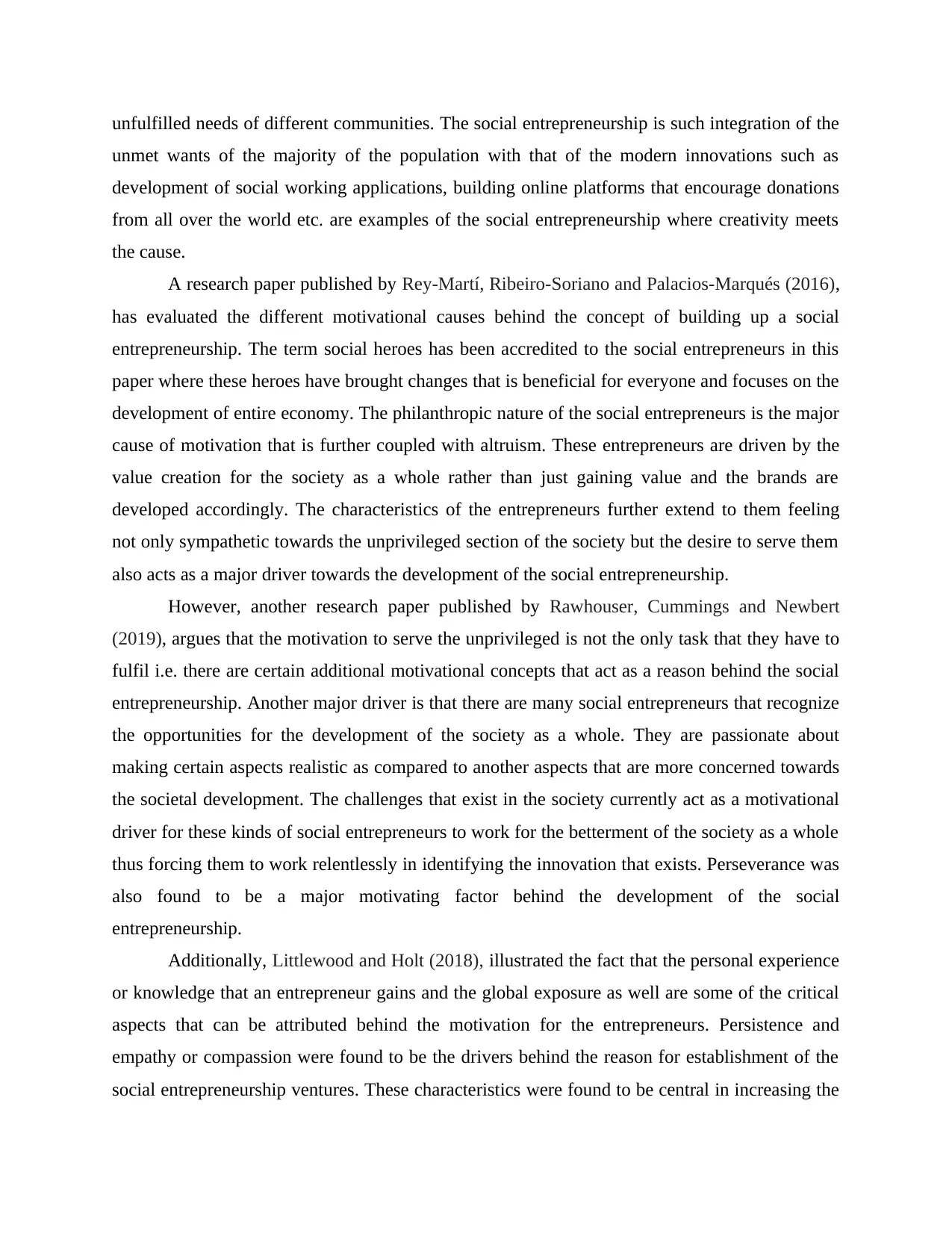
unfulfilled needs of different communities. The social entrepreneurship is such integration of the
unmet wants of the majority of the population with that of the modern innovations such as
development of social working applications, building online platforms that encourage donations
from all over the world etc. are examples of the social entrepreneurship where creativity meets
the cause.
A research paper published by Rey-Martí, Ribeiro-Soriano and Palacios-Marqués (2016),
has evaluated the different motivational causes behind the concept of building up a social
entrepreneurship. The term social heroes has been accredited to the social entrepreneurs in this
paper where these heroes have brought changes that is beneficial for everyone and focuses on the
development of entire economy. The philanthropic nature of the social entrepreneurs is the major
cause of motivation that is further coupled with altruism. These entrepreneurs are driven by the
value creation for the society as a whole rather than just gaining value and the brands are
developed accordingly. The characteristics of the entrepreneurs further extend to them feeling
not only sympathetic towards the unprivileged section of the society but the desire to serve them
also acts as a major driver towards the development of the social entrepreneurship.
However, another research paper published by Rawhouser, Cummings and Newbert
(2019), argues that the motivation to serve the unprivileged is not the only task that they have to
fulfil i.e. there are certain additional motivational concepts that act as a reason behind the social
entrepreneurship. Another major driver is that there are many social entrepreneurs that recognize
the opportunities for the development of the society as a whole. They are passionate about
making certain aspects realistic as compared to another aspects that are more concerned towards
the societal development. The challenges that exist in the society currently act as a motivational
driver for these kinds of social entrepreneurs to work for the betterment of the society as a whole
thus forcing them to work relentlessly in identifying the innovation that exists. Perseverance was
also found to be a major motivating factor behind the development of the social
entrepreneurship.
Additionally, Littlewood and Holt (2018), illustrated the fact that the personal experience
or knowledge that an entrepreneur gains and the global exposure as well are some of the critical
aspects that can be attributed behind the motivation for the entrepreneurs. Persistence and
empathy or compassion were found to be the drivers behind the reason for establishment of the
social entrepreneurship ventures. These characteristics were found to be central in increasing the
unmet wants of the majority of the population with that of the modern innovations such as
development of social working applications, building online platforms that encourage donations
from all over the world etc. are examples of the social entrepreneurship where creativity meets
the cause.
A research paper published by Rey-Martí, Ribeiro-Soriano and Palacios-Marqués (2016),
has evaluated the different motivational causes behind the concept of building up a social
entrepreneurship. The term social heroes has been accredited to the social entrepreneurs in this
paper where these heroes have brought changes that is beneficial for everyone and focuses on the
development of entire economy. The philanthropic nature of the social entrepreneurs is the major
cause of motivation that is further coupled with altruism. These entrepreneurs are driven by the
value creation for the society as a whole rather than just gaining value and the brands are
developed accordingly. The characteristics of the entrepreneurs further extend to them feeling
not only sympathetic towards the unprivileged section of the society but the desire to serve them
also acts as a major driver towards the development of the social entrepreneurship.
However, another research paper published by Rawhouser, Cummings and Newbert
(2019), argues that the motivation to serve the unprivileged is not the only task that they have to
fulfil i.e. there are certain additional motivational concepts that act as a reason behind the social
entrepreneurship. Another major driver is that there are many social entrepreneurs that recognize
the opportunities for the development of the society as a whole. They are passionate about
making certain aspects realistic as compared to another aspects that are more concerned towards
the societal development. The challenges that exist in the society currently act as a motivational
driver for these kinds of social entrepreneurs to work for the betterment of the society as a whole
thus forcing them to work relentlessly in identifying the innovation that exists. Perseverance was
also found to be a major motivating factor behind the development of the social
entrepreneurship.
Additionally, Littlewood and Holt (2018), illustrated the fact that the personal experience
or knowledge that an entrepreneur gains and the global exposure as well are some of the critical
aspects that can be attributed behind the motivation for the entrepreneurs. Persistence and
empathy or compassion were found to be the drivers behind the reason for establishment of the
social entrepreneurship ventures. These characteristics were found to be central in increasing the
Secure Best Marks with AI Grader
Need help grading? Try our AI Grader for instant feedback on your assignments.
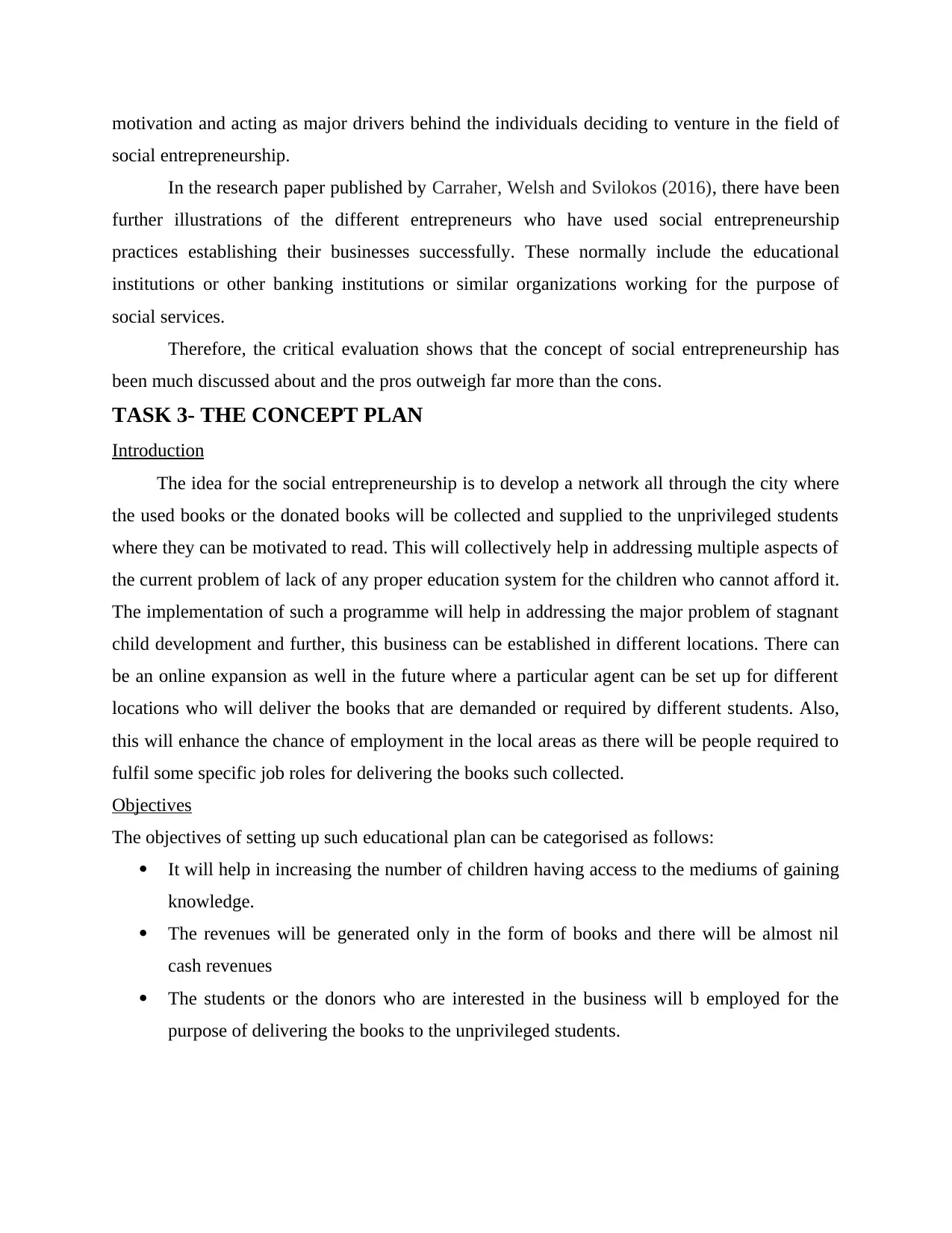
motivation and acting as major drivers behind the individuals deciding to venture in the field of
social entrepreneurship.
In the research paper published by Carraher, Welsh and Svilokos (2016), there have been
further illustrations of the different entrepreneurs who have used social entrepreneurship
practices establishing their businesses successfully. These normally include the educational
institutions or other banking institutions or similar organizations working for the purpose of
social services.
Therefore, the critical evaluation shows that the concept of social entrepreneurship has
been much discussed about and the pros outweigh far more than the cons.
TASK 3- THE CONCEPT PLAN
Introduction
The idea for the social entrepreneurship is to develop a network all through the city where
the used books or the donated books will be collected and supplied to the unprivileged students
where they can be motivated to read. This will collectively help in addressing multiple aspects of
the current problem of lack of any proper education system for the children who cannot afford it.
The implementation of such a programme will help in addressing the major problem of stagnant
child development and further, this business can be established in different locations. There can
be an online expansion as well in the future where a particular agent can be set up for different
locations who will deliver the books that are demanded or required by different students. Also,
this will enhance the chance of employment in the local areas as there will be people required to
fulfil some specific job roles for delivering the books such collected.
Objectives
The objectives of setting up such educational plan can be categorised as follows:
It will help in increasing the number of children having access to the mediums of gaining
knowledge.
The revenues will be generated only in the form of books and there will be almost nil
cash revenues
The students or the donors who are interested in the business will b employed for the
purpose of delivering the books to the unprivileged students.
social entrepreneurship.
In the research paper published by Carraher, Welsh and Svilokos (2016), there have been
further illustrations of the different entrepreneurs who have used social entrepreneurship
practices establishing their businesses successfully. These normally include the educational
institutions or other banking institutions or similar organizations working for the purpose of
social services.
Therefore, the critical evaluation shows that the concept of social entrepreneurship has
been much discussed about and the pros outweigh far more than the cons.
TASK 3- THE CONCEPT PLAN
Introduction
The idea for the social entrepreneurship is to develop a network all through the city where
the used books or the donated books will be collected and supplied to the unprivileged students
where they can be motivated to read. This will collectively help in addressing multiple aspects of
the current problem of lack of any proper education system for the children who cannot afford it.
The implementation of such a programme will help in addressing the major problem of stagnant
child development and further, this business can be established in different locations. There can
be an online expansion as well in the future where a particular agent can be set up for different
locations who will deliver the books that are demanded or required by different students. Also,
this will enhance the chance of employment in the local areas as there will be people required to
fulfil some specific job roles for delivering the books such collected.
Objectives
The objectives of setting up such educational plan can be categorised as follows:
It will help in increasing the number of children having access to the mediums of gaining
knowledge.
The revenues will be generated only in the form of books and there will be almost nil
cash revenues
The students or the donors who are interested in the business will b employed for the
purpose of delivering the books to the unprivileged students.
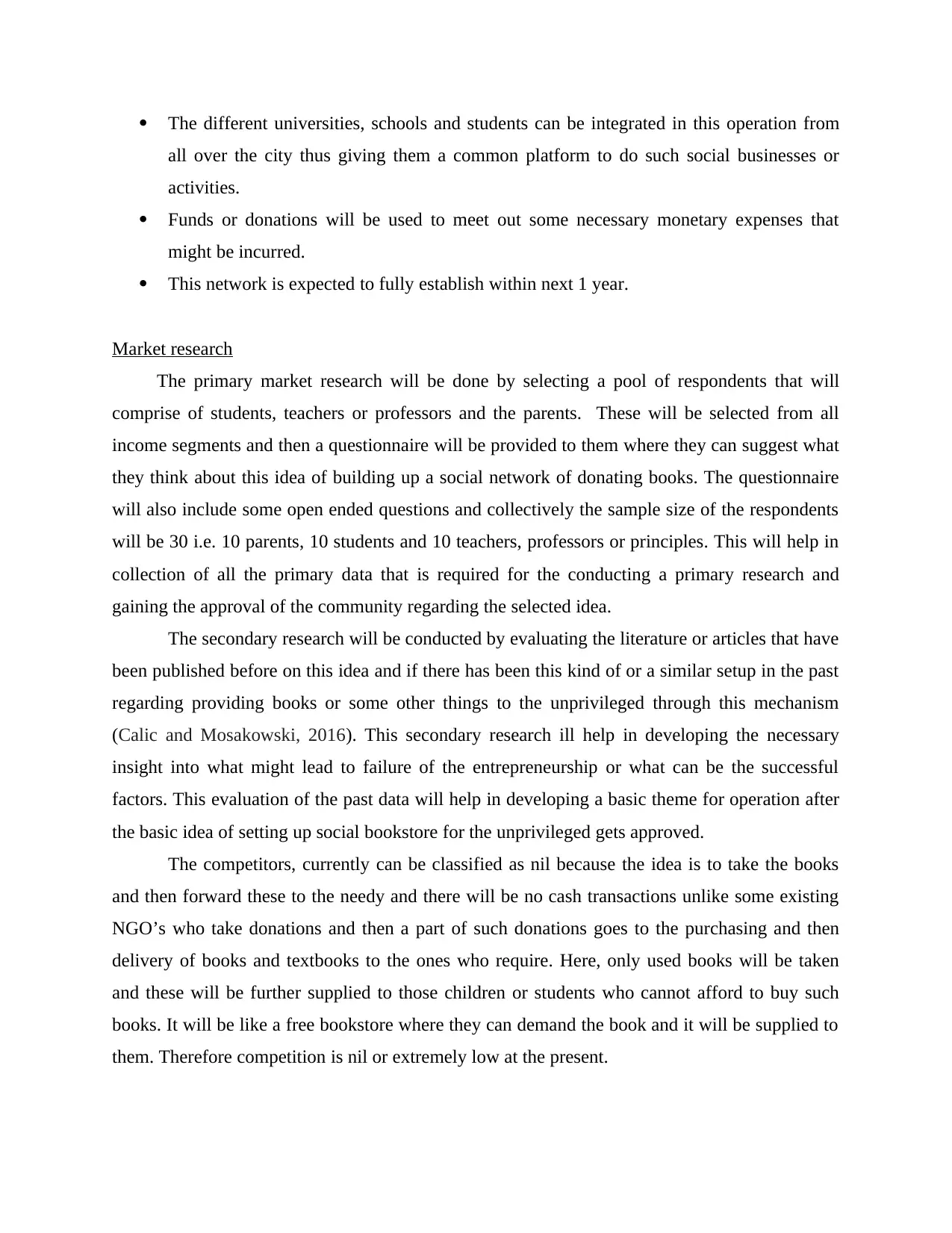
The different universities, schools and students can be integrated in this operation from
all over the city thus giving them a common platform to do such social businesses or
activities.
Funds or donations will be used to meet out some necessary monetary expenses that
might be incurred.
This network is expected to fully establish within next 1 year.
Market research
The primary market research will be done by selecting a pool of respondents that will
comprise of students, teachers or professors and the parents. These will be selected from all
income segments and then a questionnaire will be provided to them where they can suggest what
they think about this idea of building up a social network of donating books. The questionnaire
will also include some open ended questions and collectively the sample size of the respondents
will be 30 i.e. 10 parents, 10 students and 10 teachers, professors or principles. This will help in
collection of all the primary data that is required for the conducting a primary research and
gaining the approval of the community regarding the selected idea.
The secondary research will be conducted by evaluating the literature or articles that have
been published before on this idea and if there has been this kind of or a similar setup in the past
regarding providing books or some other things to the unprivileged through this mechanism
(Calic and Mosakowski, 2016). This secondary research ill help in developing the necessary
insight into what might lead to failure of the entrepreneurship or what can be the successful
factors. This evaluation of the past data will help in developing a basic theme for operation after
the basic idea of setting up social bookstore for the unprivileged gets approved.
The competitors, currently can be classified as nil because the idea is to take the books
and then forward these to the needy and there will be no cash transactions unlike some existing
NGO’s who take donations and then a part of such donations goes to the purchasing and then
delivery of books and textbooks to the ones who require. Here, only used books will be taken
and these will be further supplied to those children or students who cannot afford to buy such
books. It will be like a free bookstore where they can demand the book and it will be supplied to
them. Therefore competition is nil or extremely low at the present.
all over the city thus giving them a common platform to do such social businesses or
activities.
Funds or donations will be used to meet out some necessary monetary expenses that
might be incurred.
This network is expected to fully establish within next 1 year.
Market research
The primary market research will be done by selecting a pool of respondents that will
comprise of students, teachers or professors and the parents. These will be selected from all
income segments and then a questionnaire will be provided to them where they can suggest what
they think about this idea of building up a social network of donating books. The questionnaire
will also include some open ended questions and collectively the sample size of the respondents
will be 30 i.e. 10 parents, 10 students and 10 teachers, professors or principles. This will help in
collection of all the primary data that is required for the conducting a primary research and
gaining the approval of the community regarding the selected idea.
The secondary research will be conducted by evaluating the literature or articles that have
been published before on this idea and if there has been this kind of or a similar setup in the past
regarding providing books or some other things to the unprivileged through this mechanism
(Calic and Mosakowski, 2016). This secondary research ill help in developing the necessary
insight into what might lead to failure of the entrepreneurship or what can be the successful
factors. This evaluation of the past data will help in developing a basic theme for operation after
the basic idea of setting up social bookstore for the unprivileged gets approved.
The competitors, currently can be classified as nil because the idea is to take the books
and then forward these to the needy and there will be no cash transactions unlike some existing
NGO’s who take donations and then a part of such donations goes to the purchasing and then
delivery of books and textbooks to the ones who require. Here, only used books will be taken
and these will be further supplied to those children or students who cannot afford to buy such
books. It will be like a free bookstore where they can demand the book and it will be supplied to
them. Therefore competition is nil or extremely low at the present.
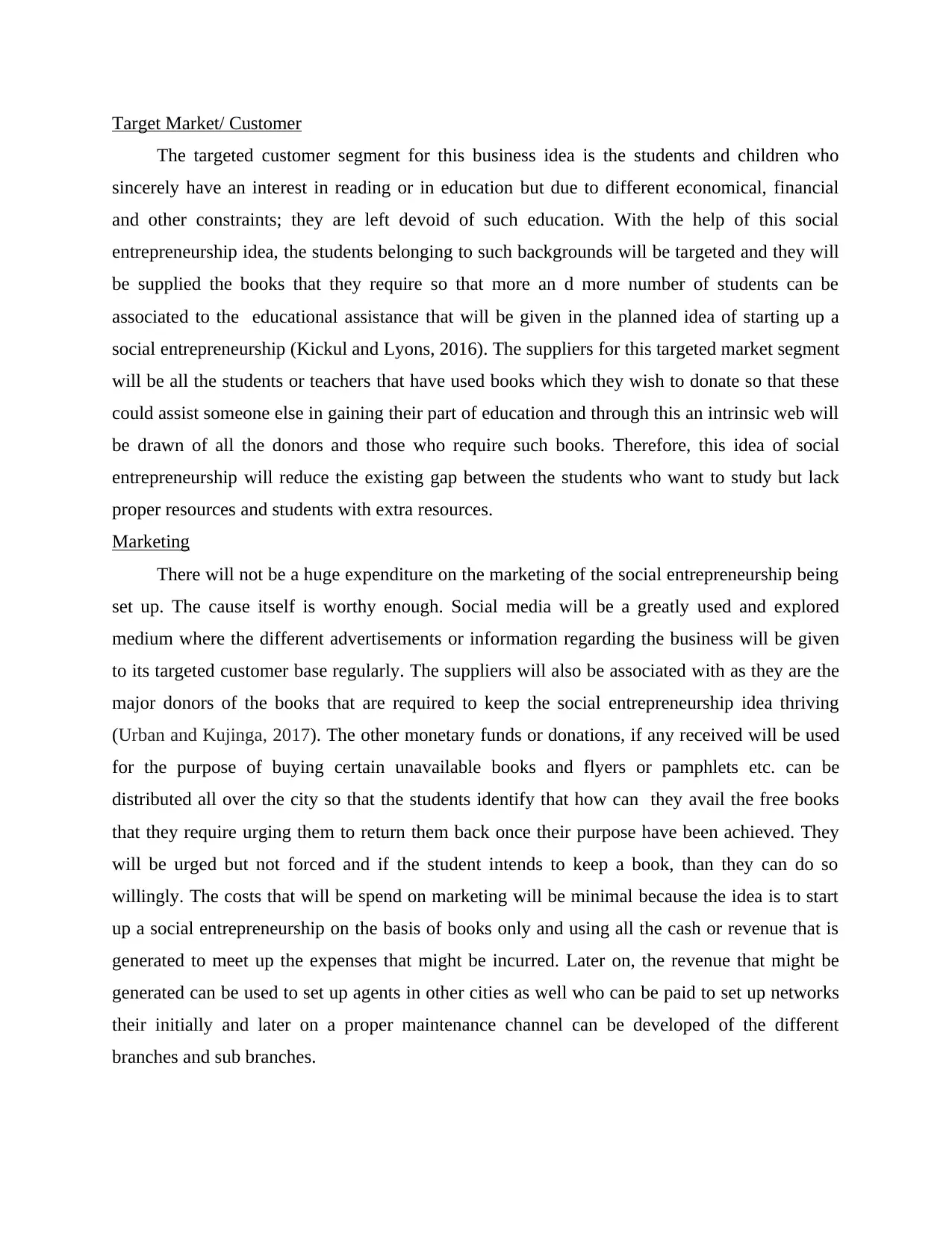
Target Market/ Customer
The targeted customer segment for this business idea is the students and children who
sincerely have an interest in reading or in education but due to different economical, financial
and other constraints; they are left devoid of such education. With the help of this social
entrepreneurship idea, the students belonging to such backgrounds will be targeted and they will
be supplied the books that they require so that more an d more number of students can be
associated to the educational assistance that will be given in the planned idea of starting up a
social entrepreneurship (Kickul and Lyons, 2016). The suppliers for this targeted market segment
will be all the students or teachers that have used books which they wish to donate so that these
could assist someone else in gaining their part of education and through this an intrinsic web will
be drawn of all the donors and those who require such books. Therefore, this idea of social
entrepreneurship will reduce the existing gap between the students who want to study but lack
proper resources and students with extra resources.
Marketing
There will not be a huge expenditure on the marketing of the social entrepreneurship being
set up. The cause itself is worthy enough. Social media will be a greatly used and explored
medium where the different advertisements or information regarding the business will be given
to its targeted customer base regularly. The suppliers will also be associated with as they are the
major donors of the books that are required to keep the social entrepreneurship idea thriving
(Urban and Kujinga, 2017). The other monetary funds or donations, if any received will be used
for the purpose of buying certain unavailable books and flyers or pamphlets etc. can be
distributed all over the city so that the students identify that how can they avail the free books
that they require urging them to return them back once their purpose have been achieved. They
will be urged but not forced and if the student intends to keep a book, than they can do so
willingly. The costs that will be spend on marketing will be minimal because the idea is to start
up a social entrepreneurship on the basis of books only and using all the cash or revenue that is
generated to meet up the expenses that might be incurred. Later on, the revenue that might be
generated can be used to set up agents in other cities as well who can be paid to set up networks
their initially and later on a proper maintenance channel can be developed of the different
branches and sub branches.
The targeted customer segment for this business idea is the students and children who
sincerely have an interest in reading or in education but due to different economical, financial
and other constraints; they are left devoid of such education. With the help of this social
entrepreneurship idea, the students belonging to such backgrounds will be targeted and they will
be supplied the books that they require so that more an d more number of students can be
associated to the educational assistance that will be given in the planned idea of starting up a
social entrepreneurship (Kickul and Lyons, 2016). The suppliers for this targeted market segment
will be all the students or teachers that have used books which they wish to donate so that these
could assist someone else in gaining their part of education and through this an intrinsic web will
be drawn of all the donors and those who require such books. Therefore, this idea of social
entrepreneurship will reduce the existing gap between the students who want to study but lack
proper resources and students with extra resources.
Marketing
There will not be a huge expenditure on the marketing of the social entrepreneurship being
set up. The cause itself is worthy enough. Social media will be a greatly used and explored
medium where the different advertisements or information regarding the business will be given
to its targeted customer base regularly. The suppliers will also be associated with as they are the
major donors of the books that are required to keep the social entrepreneurship idea thriving
(Urban and Kujinga, 2017). The other monetary funds or donations, if any received will be used
for the purpose of buying certain unavailable books and flyers or pamphlets etc. can be
distributed all over the city so that the students identify that how can they avail the free books
that they require urging them to return them back once their purpose have been achieved. They
will be urged but not forced and if the student intends to keep a book, than they can do so
willingly. The costs that will be spend on marketing will be minimal because the idea is to start
up a social entrepreneurship on the basis of books only and using all the cash or revenue that is
generated to meet up the expenses that might be incurred. Later on, the revenue that might be
generated can be used to set up agents in other cities as well who can be paid to set up networks
their initially and later on a proper maintenance channel can be developed of the different
branches and sub branches.
Paraphrase This Document
Need a fresh take? Get an instant paraphrase of this document with our AI Paraphraser
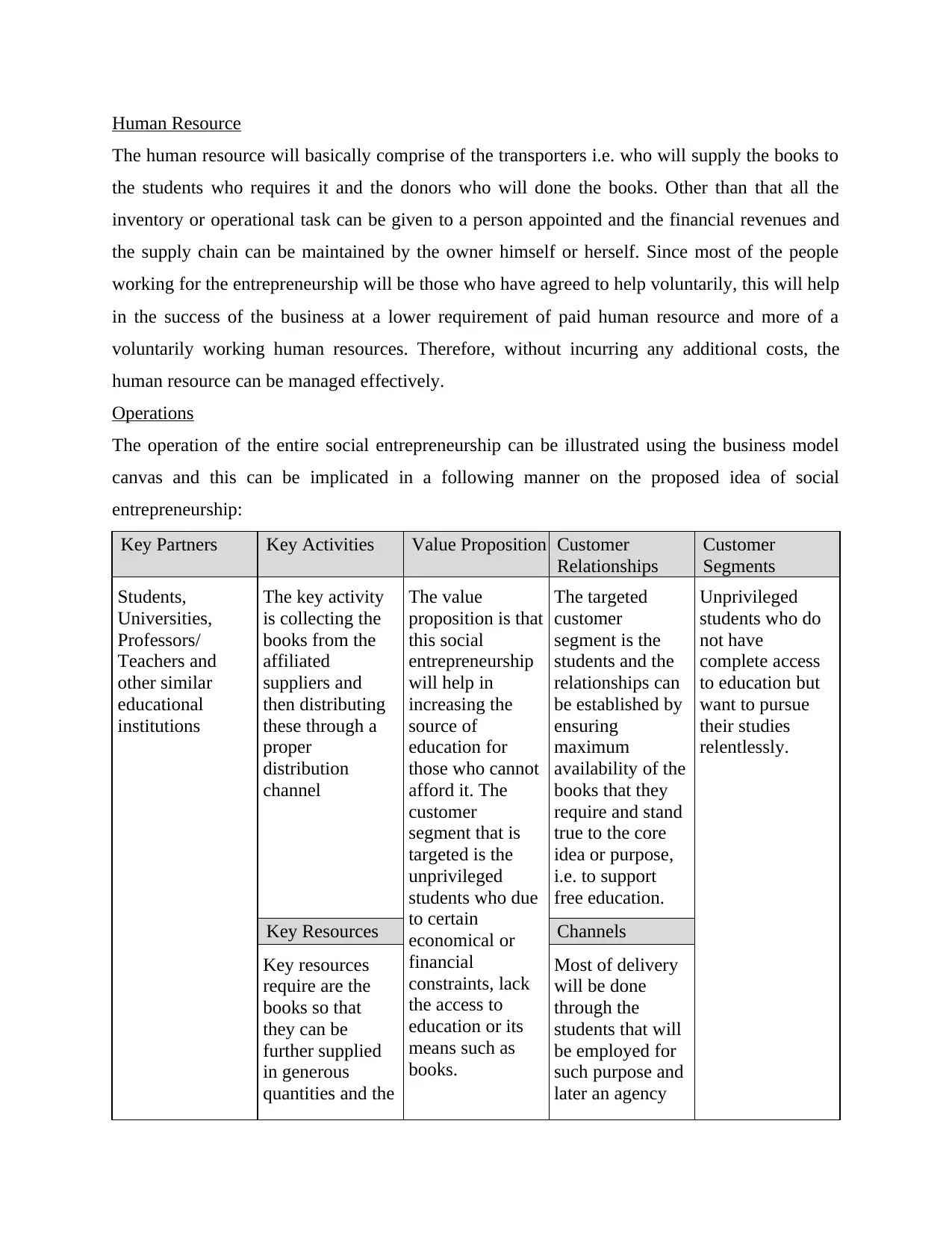
Human Resource
The human resource will basically comprise of the transporters i.e. who will supply the books to
the students who requires it and the donors who will done the books. Other than that all the
inventory or operational task can be given to a person appointed and the financial revenues and
the supply chain can be maintained by the owner himself or herself. Since most of the people
working for the entrepreneurship will be those who have agreed to help voluntarily, this will help
in the success of the business at a lower requirement of paid human resource and more of a
voluntarily working human resources. Therefore, without incurring any additional costs, the
human resource can be managed effectively.
Operations
The operation of the entire social entrepreneurship can be illustrated using the business model
canvas and this can be implicated in a following manner on the proposed idea of social
entrepreneurship:
Key Partners Key Activities Value Proposition Customer
Relationships
Customer
Segments
Students,
Universities,
Professors/
Teachers and
other similar
educational
institutions
The key activity
is collecting the
books from the
affiliated
suppliers and
then distributing
these through a
proper
distribution
channel
The value
proposition is that
this social
entrepreneurship
will help in
increasing the
source of
education for
those who cannot
afford it. The
customer
segment that is
targeted is the
unprivileged
students who due
to certain
economical or
financial
constraints, lack
the access to
education or its
means such as
books.
The targeted
customer
segment is the
students and the
relationships can
be established by
ensuring
maximum
availability of the
books that they
require and stand
true to the core
idea or purpose,
i.e. to support
free education.
Unprivileged
students who do
not have
complete access
to education but
want to pursue
their studies
relentlessly.
Key Resources Channels
Key resources
require are the
books so that
they can be
further supplied
in generous
quantities and the
Most of delivery
will be done
through the
students that will
be employed for
such purpose and
later an agency
The human resource will basically comprise of the transporters i.e. who will supply the books to
the students who requires it and the donors who will done the books. Other than that all the
inventory or operational task can be given to a person appointed and the financial revenues and
the supply chain can be maintained by the owner himself or herself. Since most of the people
working for the entrepreneurship will be those who have agreed to help voluntarily, this will help
in the success of the business at a lower requirement of paid human resource and more of a
voluntarily working human resources. Therefore, without incurring any additional costs, the
human resource can be managed effectively.
Operations
The operation of the entire social entrepreneurship can be illustrated using the business model
canvas and this can be implicated in a following manner on the proposed idea of social
entrepreneurship:
Key Partners Key Activities Value Proposition Customer
Relationships
Customer
Segments
Students,
Universities,
Professors/
Teachers and
other similar
educational
institutions
The key activity
is collecting the
books from the
affiliated
suppliers and
then distributing
these through a
proper
distribution
channel
The value
proposition is that
this social
entrepreneurship
will help in
increasing the
source of
education for
those who cannot
afford it. The
customer
segment that is
targeted is the
unprivileged
students who due
to certain
economical or
financial
constraints, lack
the access to
education or its
means such as
books.
The targeted
customer
segment is the
students and the
relationships can
be established by
ensuring
maximum
availability of the
books that they
require and stand
true to the core
idea or purpose,
i.e. to support
free education.
Unprivileged
students who do
not have
complete access
to education but
want to pursue
their studies
relentlessly.
Key Resources Channels
Key resources
require are the
books so that
they can be
further supplied
in generous
quantities and the
Most of delivery
will be done
through the
students that will
be employed for
such purpose and
later an agency
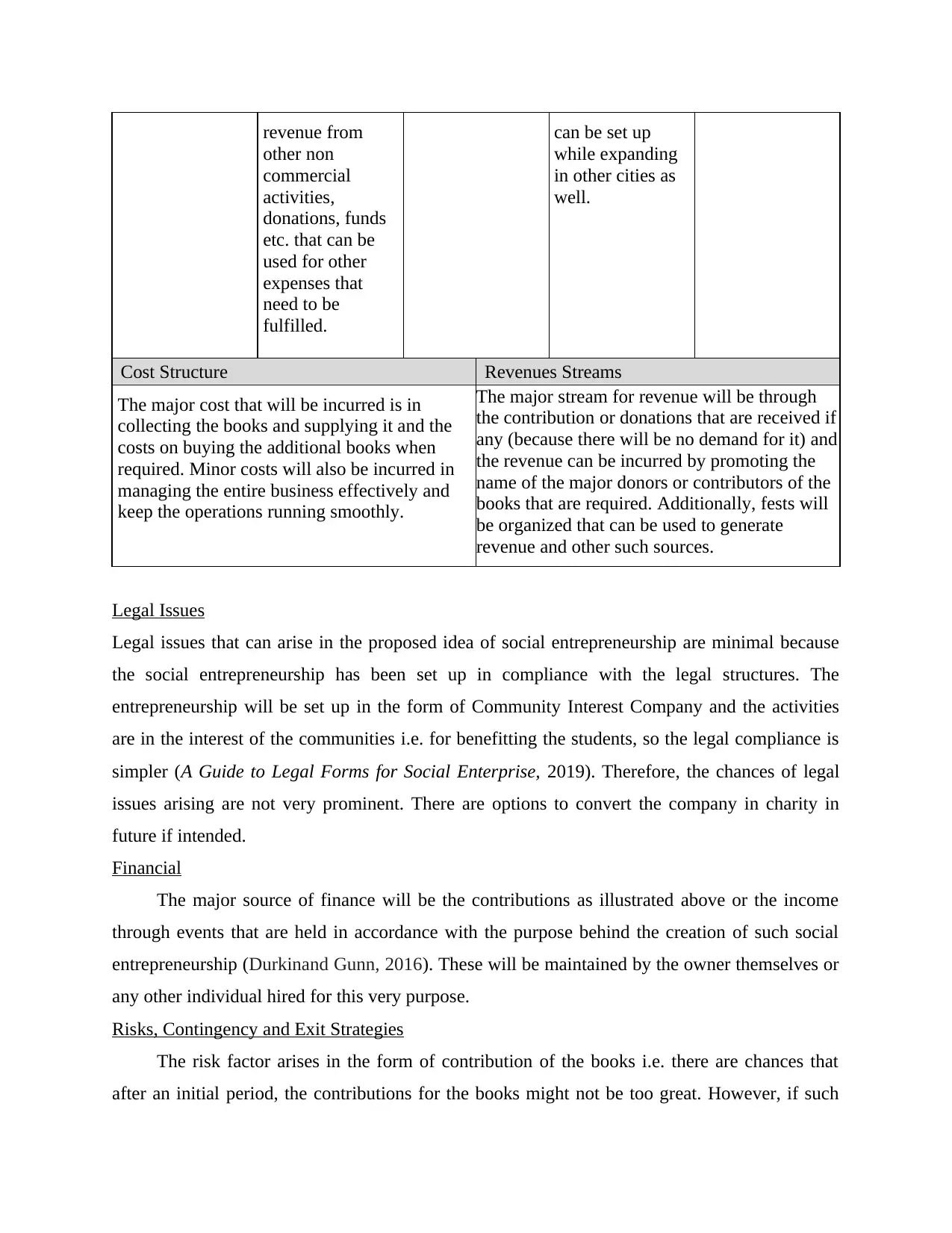
revenue from
other non
commercial
activities,
donations, funds
etc. that can be
used for other
expenses that
need to be
fulfilled.
can be set up
while expanding
in other cities as
well.
Cost Structure Revenues Streams
The major cost that will be incurred is in
collecting the books and supplying it and the
costs on buying the additional books when
required. Minor costs will also be incurred in
managing the entire business effectively and
keep the operations running smoothly.
The major stream for revenue will be through
the contribution or donations that are received if
any (because there will be no demand for it) and
the revenue can be incurred by promoting the
name of the major donors or contributors of the
books that are required. Additionally, fests will
be organized that can be used to generate
revenue and other such sources.
Legal Issues
Legal issues that can arise in the proposed idea of social entrepreneurship are minimal because
the social entrepreneurship has been set up in compliance with the legal structures. The
entrepreneurship will be set up in the form of Community Interest Company and the activities
are in the interest of the communities i.e. for benefitting the students, so the legal compliance is
simpler (A Guide to Legal Forms for Social Enterprise, 2019). Therefore, the chances of legal
issues arising are not very prominent. There are options to convert the company in charity in
future if intended.
Financial
The major source of finance will be the contributions as illustrated above or the income
through events that are held in accordance with the purpose behind the creation of such social
entrepreneurship (Durkinand Gunn, 2016). These will be maintained by the owner themselves or
any other individual hired for this very purpose.
Risks, Contingency and Exit Strategies
The risk factor arises in the form of contribution of the books i.e. there are chances that
after an initial period, the contributions for the books might not be too great. However, if such
other non
commercial
activities,
donations, funds
etc. that can be
used for other
expenses that
need to be
fulfilled.
can be set up
while expanding
in other cities as
well.
Cost Structure Revenues Streams
The major cost that will be incurred is in
collecting the books and supplying it and the
costs on buying the additional books when
required. Minor costs will also be incurred in
managing the entire business effectively and
keep the operations running smoothly.
The major stream for revenue will be through
the contribution or donations that are received if
any (because there will be no demand for it) and
the revenue can be incurred by promoting the
name of the major donors or contributors of the
books that are required. Additionally, fests will
be organized that can be used to generate
revenue and other such sources.
Legal Issues
Legal issues that can arise in the proposed idea of social entrepreneurship are minimal because
the social entrepreneurship has been set up in compliance with the legal structures. The
entrepreneurship will be set up in the form of Community Interest Company and the activities
are in the interest of the communities i.e. for benefitting the students, so the legal compliance is
simpler (A Guide to Legal Forms for Social Enterprise, 2019). Therefore, the chances of legal
issues arising are not very prominent. There are options to convert the company in charity in
future if intended.
Financial
The major source of finance will be the contributions as illustrated above or the income
through events that are held in accordance with the purpose behind the creation of such social
entrepreneurship (Durkinand Gunn, 2016). These will be maintained by the owner themselves or
any other individual hired for this very purpose.
Risks, Contingency and Exit Strategies
The risk factor arises in the form of contribution of the books i.e. there are chances that
after an initial period, the contributions for the books might not be too great. However, if such

contingency arises than for that also strategies have been developed such as asking students to
donate their books after semester gets finished and developing ties with the universities.
If the idea fails entirely, then the CIC exit options are easy and voluntary dissolvement is
the easiest exit strategy that can be adopted for the social entrepreneurship.
Other Issues
There are other issues as well such as the students who require educational assistance might
not feel comfortable taking assistance from the entrepreneurship company. There are other
similar issues such as they might not understand the channel to reach us etc. this can be
addressed by developing a good marketing campaign initially but one which is not too heavy on
costs.
CONCLUSION
The report above concluded that the innovation and entrepreneurship walk hand in hand and
discussed the novel concept of social entrepreneurship. The report also conducted a critical
evaluation on the concept of social entrepreneurship and the motivation factors behind adopting
such entrepreneurial venture technique. Finally a concept plan was developed in the report
detailing a brief business plan for setting up a social entrepreneurship that provides books to the
students who cannot afford it.
donate their books after semester gets finished and developing ties with the universities.
If the idea fails entirely, then the CIC exit options are easy and voluntary dissolvement is
the easiest exit strategy that can be adopted for the social entrepreneurship.
Other Issues
There are other issues as well such as the students who require educational assistance might
not feel comfortable taking assistance from the entrepreneurship company. There are other
similar issues such as they might not understand the channel to reach us etc. this can be
addressed by developing a good marketing campaign initially but one which is not too heavy on
costs.
CONCLUSION
The report above concluded that the innovation and entrepreneurship walk hand in hand and
discussed the novel concept of social entrepreneurship. The report also conducted a critical
evaluation on the concept of social entrepreneurship and the motivation factors behind adopting
such entrepreneurial venture technique. Finally a concept plan was developed in the report
detailing a brief business plan for setting up a social entrepreneurship that provides books to the
students who cannot afford it.
Secure Best Marks with AI Grader
Need help grading? Try our AI Grader for instant feedback on your assignments.
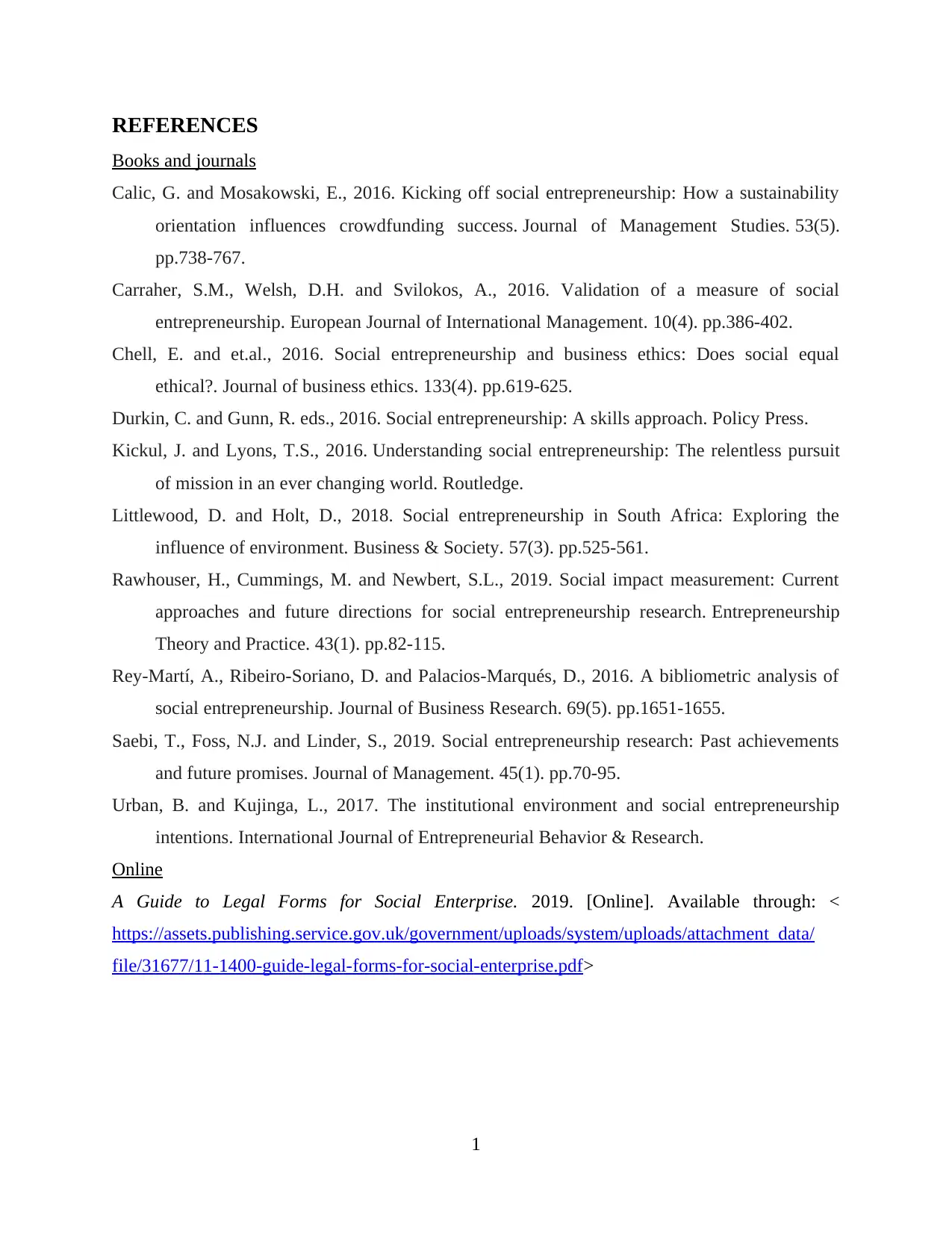
REFERENCES
Books and journals
Calic, G. and Mosakowski, E., 2016. Kicking off social entrepreneurship: How a sustainability
orientation influences crowdfunding success. Journal of Management Studies. 53(5).
pp.738-767.
Carraher, S.M., Welsh, D.H. and Svilokos, A., 2016. Validation of a measure of social
entrepreneurship. European Journal of International Management. 10(4). pp.386-402.
Chell, E. and et.al., 2016. Social entrepreneurship and business ethics: Does social equal
ethical?. Journal of business ethics. 133(4). pp.619-625.
Durkin, C. and Gunn, R. eds., 2016. Social entrepreneurship: A skills approach. Policy Press.
Kickul, J. and Lyons, T.S., 2016. Understanding social entrepreneurship: The relentless pursuit
of mission in an ever changing world. Routledge.
Littlewood, D. and Holt, D., 2018. Social entrepreneurship in South Africa: Exploring the
influence of environment. Business & Society. 57(3). pp.525-561.
Rawhouser, H., Cummings, M. and Newbert, S.L., 2019. Social impact measurement: Current
approaches and future directions for social entrepreneurship research. Entrepreneurship
Theory and Practice. 43(1). pp.82-115.
Rey-Martí, A., Ribeiro-Soriano, D. and Palacios-Marqués, D., 2016. A bibliometric analysis of
social entrepreneurship. Journal of Business Research. 69(5). pp.1651-1655.
Saebi, T., Foss, N.J. and Linder, S., 2019. Social entrepreneurship research: Past achievements
and future promises. Journal of Management. 45(1). pp.70-95.
Urban, B. and Kujinga, L., 2017. The institutional environment and social entrepreneurship
intentions. International Journal of Entrepreneurial Behavior & Research.
Online
A Guide to Legal Forms for Social Enterprise. 2019. [Online]. Available through: <
https://assets.publishing.service.gov.uk/government/uploads/system/uploads/attachment_data/
file/31677/11-1400-guide-legal-forms-for-social-enterprise.pdf>
1
Books and journals
Calic, G. and Mosakowski, E., 2016. Kicking off social entrepreneurship: How a sustainability
orientation influences crowdfunding success. Journal of Management Studies. 53(5).
pp.738-767.
Carraher, S.M., Welsh, D.H. and Svilokos, A., 2016. Validation of a measure of social
entrepreneurship. European Journal of International Management. 10(4). pp.386-402.
Chell, E. and et.al., 2016. Social entrepreneurship and business ethics: Does social equal
ethical?. Journal of business ethics. 133(4). pp.619-625.
Durkin, C. and Gunn, R. eds., 2016. Social entrepreneurship: A skills approach. Policy Press.
Kickul, J. and Lyons, T.S., 2016. Understanding social entrepreneurship: The relentless pursuit
of mission in an ever changing world. Routledge.
Littlewood, D. and Holt, D., 2018. Social entrepreneurship in South Africa: Exploring the
influence of environment. Business & Society. 57(3). pp.525-561.
Rawhouser, H., Cummings, M. and Newbert, S.L., 2019. Social impact measurement: Current
approaches and future directions for social entrepreneurship research. Entrepreneurship
Theory and Practice. 43(1). pp.82-115.
Rey-Martí, A., Ribeiro-Soriano, D. and Palacios-Marqués, D., 2016. A bibliometric analysis of
social entrepreneurship. Journal of Business Research. 69(5). pp.1651-1655.
Saebi, T., Foss, N.J. and Linder, S., 2019. Social entrepreneurship research: Past achievements
and future promises. Journal of Management. 45(1). pp.70-95.
Urban, B. and Kujinga, L., 2017. The institutional environment and social entrepreneurship
intentions. International Journal of Entrepreneurial Behavior & Research.
Online
A Guide to Legal Forms for Social Enterprise. 2019. [Online]. Available through: <
https://assets.publishing.service.gov.uk/government/uploads/system/uploads/attachment_data/
file/31677/11-1400-guide-legal-forms-for-social-enterprise.pdf>
1

2
1 out of 12
Related Documents
Your All-in-One AI-Powered Toolkit for Academic Success.
+13062052269
info@desklib.com
Available 24*7 on WhatsApp / Email
![[object Object]](/_next/static/media/star-bottom.7253800d.svg)
Unlock your academic potential
© 2024 | Zucol Services PVT LTD | All rights reserved.





